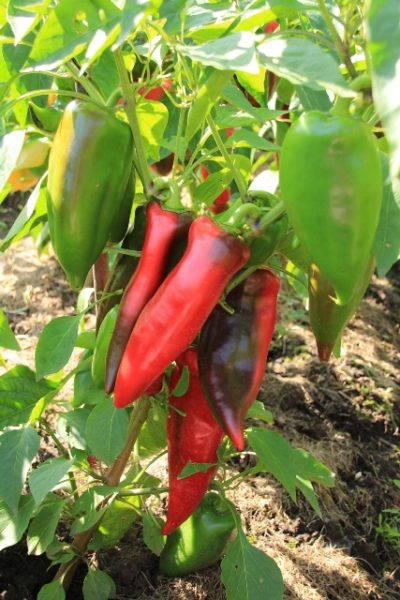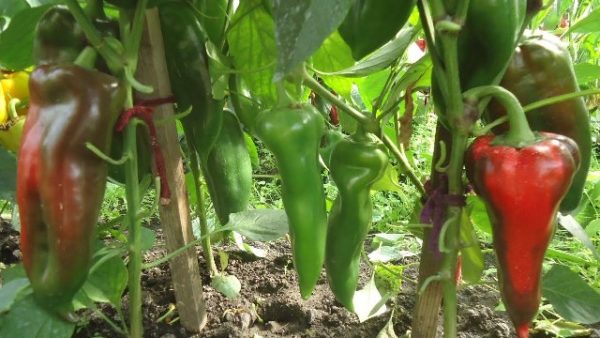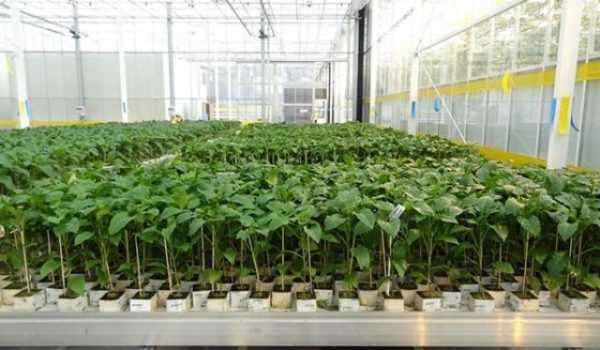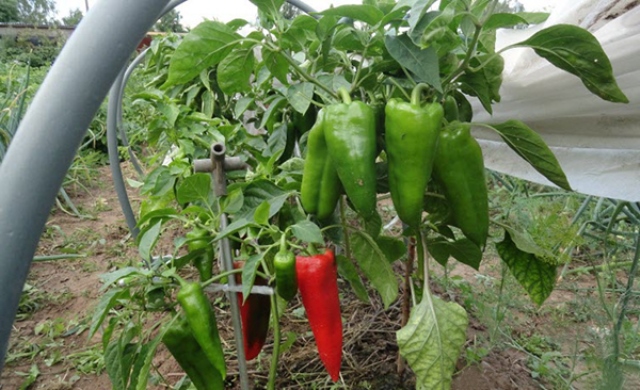Sweet pepper The ox-ear is one of the most popular and popular varieties grown by Russian gardeners on their land plots. Designed for film greenhouses and open ground, it gives good yields in a temperate climate of our country. It is not surprising that farmers grow this variety for sale, and amateur gardeners give it the best places on the plot. Today we will talk about the description, technical characteristics of the variety of sweet pepper, ox-ear, the characteristics of its cultivation and storage, as well as the advantages and disadvantages.
Table of contents
Characteristics of pepper varieties cowhide
The ox-ox ear refers to mid-season varieties, the approximate maturity of which is 112-130 days from the appearance of the very first shoots, or about 70 days from the time the seedlings are planted in open ground. A strong bush can grow up to 75-80 centimeters, forming a spreading crown and an abundance of leaves. With proper care from one bush, you can get a crop of up to 2.5-3 kilograms. Harvest can be harvested until mid-September under favorable weather conditions.
Fruits have a dark green color in technical maturity and thick red when fully ripe. Peppers of elongated shape with a pointed tip can reach a length of 15 cm, and a weight of 170-200 grams. The wall thickness is on average 6-8 millimeters, the flesh is dense and juicy. The taste of the fruit is sweet, rich, but without the bitterness inherent in many varieties of pepper. Well suited for eating raw (preparing salads and vegetable smoothies) and in canned (various dressings, lecho, vegetable blanks).

Advantages and disadvantages
Among the advantages of sweet pepper in this variety include:
- excellent taste;
- good transportability;
- possibility of long-term storage;
- resistance to most diseases of the pepper;
- high yield;
- early ripening;
- the possibility of eating raw and processing canned food.
The disadvantages include:
- low resistance to cold and frost (in spring, young plants die during frost in the air and on the surface of the ground);
- the need for sunlight (the plant must be grown in sunny or partially shaded areas);
- intolerance to heat (at temperatures above 30-32 degrees in the greenhouse the flowers and the young ovary begin to fall off);
- the need for watering in the absence of rain (before flowering by sprinkling, after - at the root).

Features of growing
Like most peppers, ox ox ear is grown with seedlings. The main feature of this variety is that the shoots do not tolerate frequent replanting, and therefore diving.
And after landing in the garden the bushes must be regularly watered., loosen the ground around them, destroy weeds and periodically apply fertilizer (preferably organic).
Selection and planting seed
Before planting the seeds in the boxes for seedlings they need to be calibrated and prepared. You can start all the work on growing seedlings in 10-20 of March. Calibration is an important step in the cultivation of seedlings, as it allows you to significantly increase germination (in pepper it is only 50%). Seed preparation consists of the following steps:
- Seed sorting. Planting material is lowered into water at room temperature for a few minutes. For planting are used only those seeds that fall to the bottom of the tank with water. The rest are not suitable for germination - they are either overdried or underdeveloped.
- Soak. For 3-4 days the seeds should be soaked in warm water (26-28 degrees). You can put gauze on a flat dish in 2-4 layers, pour a little warm water to get wet gauze. Place the seeds on top and leave for a few days (it is important to add warm water in time so that the gauze and seeds do not dry out).Instead of water, you can use a very weak solution of potassium permanganate.
- Soil preparation. For seedlings, you can also use store priming mixture, but it is better to take the land from the site where the pepper will be grown. It is necessary to add to the ground sand in the ratio of 5: 1 and 2-3 handfuls of wood ash. It is necessary to moisten the earth well and leave it for a couple of days in a warm place so that it warms up.
- Planting seeds. Seeds are best planted immediately, taking into account the fact that they do not have to dive later. After planting seed, boxes can be closed on top of the film and put in a relatively warm place (the temperature should not be below 20-18 degrees).
- Thinning. If the seedlings have grown very thick - it should be thinned, removing weak sprouts. After the appearance of 4-6 leaves, it is desirable to add earth to the box so that the shoots are strong. It is also necessary for the seedlings to provide sufficient illumination, otherwise it will grow thin and high (or will simply die stretching towards the light).

Features care for the bushes in the greenhouse and open ground
Seedlings are planted at the beginning - in the middle of May only after the frosts have stopped.At the same time, the temperature of the air at night should not be lower than 18 degrees, otherwise gentle young leaves can freeze. If the ground is not sufficiently heated, young pepper bushes can become unwell, which means that the harvest will not be as abundant.
Watering should be carried out regularly, especially if the summer is dry:
- before flowering and the formation of the first ovary - by the rain method (spraying water through bushes and row-spacing);
- at flowering and until the end of fruiting - at the root.
For irrigation, you can take water with a temperature not lower than 25-27 degrees.
Pepper can be fed with both superphosphate and “organic” - slurry or bird droppings. During flowering, it is desirable to make complex fertilizers to get a good harvest.

Diseases and pests
The variety is excellent against most diseases that can affect both fruits. So is the stem of the plant or its root.
However, plants cannot effectively resist such pests as:
- Aphid - you can destroy it only by applying insecticides;
- spider mite disappears after spraying with a solution of soap with the addition of garlic juice and onions;
- bare slugs do not like tobacco dust and mustard;
- Colorado potato beetle - it can be sprayed with celandine tincture.
Many farmers and amateur growers grow bell pepper. Ox ox ear every year. In their reviews, they note not only the excellent taste and versatility of the variety. Large yields, disease resistance, short maturation, good keeping quality and transportability - these are the main qualities that are appreciated by both ordinary gardeners and reputable farms.
